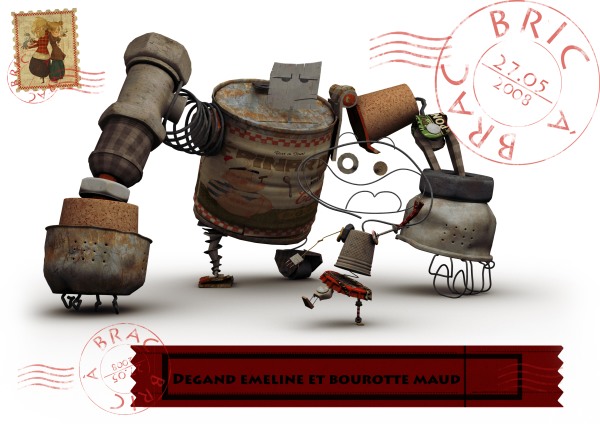Back from Cinéma Lux in La Châtre and Berry Movies!
Here is a list and some video clips with the competing films:
Here is a list and some video clips with the competing films:
Nouveau monde, directed by Hervé André from Sauvigny-les-Bois
(Des êtres étranges, un langage incompréhensible, des expériences inquiétantes, ici tout est bizarre...);
Bric à brac, produced by a group from L'Ecole Méliès in Orly (click on the image). (Rencontre et cycle de vie, le temps d'une musique, de deux personnages faits d'éléments de récupération);
 Alleluia, produced by the group 61 du Cygne from Clichy
Alleluia, produced by the group 61 du Cygne from Clichy("La religion est née le jour où le premier hypocrite a rencontré le premier imbécile", Voltaire);
Wesh, directed by Vivien Loiseau from Paris
(Ce soir, Jérémy a été invité à un dîner romantique par une charmante jeune femme. C'est normal, il a tout pour plaire: beau, jeune, intelligent... Entre deux rendez-vous amoureux, il sauve même le monde. Pourtant quelque chose cloche...)
WESH par floflo1971
Love and Pets, produced by Videotrack from Poitiers
(Clip musical)
WESH par floflo1971
Love and Pets, produced by Videotrack from Poitiers
(Clip musical)
(Bob veut séduire Joséphine. Mais son plus gros obstacle est peut-être...lui-même.)
Bob et Joséphine - un film de Liam Engle Vidéo Liam sélectionnée dans Cinéma
En premier, directed by Jon Smith from Bordeaux
(Clip musical)
Le vent en poupe, produced by La boîte à Fizz from La Châtre
(Une équipe TV suit le quotidien de Fabrice Poupe, maire de Pont-au-Julot /réputée pour sa production de chaussettes/ en lice pour les futures élections municipales)
(Une équipe TV suit le quotidien de Fabrice Poupe, maire de Pont-au-Julot /réputée pour sa production de chaussettes/ en lice pour les futures élections municipales)
Le Vent en Poupe par guiguidu36
Mets-toi à l'aise, directed by Joli Rôle from Trans-sur-Erdre
(Journée ordinaire, pense Ghislain en quittant la maison. Au bureau, l'accueil n'a rien d'enthousiasmant, rien ne va. Et pourtant aujourd'hui c'est son anniversaire, il a 35 ans)
(Au moment de la pause, dans le réfectoire d'une usine, quatre ouvriers aux habitudes très différentes tentent de cohabiter...)
Il était une fois la crise, directed by Matthieu Le Texier from Nohant-Vicq
(Dans une région touchée par la crise, la lutte pour l'emploi fait rage. Un affrontement sans merci se prépare. Cinq cow boys pour une offre d'emploi...)
L'avant-dernier repas, directed by Julien Lefer from Angers
(Suite à une catastrophe planétaire, un survivant erre depuis des années se nourrissant de sales bestioles. Un jour, au milieu de nul part, il découvre un frigo qui fonctionne...).
L'AVANT DERNIER REPAS par Ehoan
(Suite à une catastrophe planétaire, un survivant erre depuis des années se nourrissant de sales bestioles. Un jour, au milieu de nul part, il découvre un frigo qui fonctionne...).
L'AVANT DERNIER REPAS par Ehoan
"And the winner is...."
Nouveau Monde!
The idea to this film was quite original and it was carried out in a very entertaining and thought-provoking way.
The film opens with blurry pictures and a somewhat blueish colour and all of a sudden we see people surronding something or someone.
This someone is a baby (a couple of months old or more?) registering everything around him. What he thinks about his parents, the family, their friends, being looked at, hugged, caressed and played with, is made clear by a voice-over.
This was quite entertaining, displaying all the idiotic things we do with children and how this - possibly - could be perceived if children at that age had the possibility to speak out and analyzing events around them. Maybe they can?
This was one of my two favourite films.
Another favourite was Bric à brac (animation).
As this word is used in English too as another word for trinkets, I only have to say that the story circles around two figures made out of recycled things.
They are part of different items in a antiquity store and they both - in different ways - wants attention.
One is playing music and all of a sudden a fight or a contest emerges.
It gets so animated that one of them almost falls from a table. At that point the other figure tries to rescue his opponent (see for yourself below, if you feel like it).
This was technically perhaps the most complicated film to make and the story was well composed.
This my favourite came in fourth place in the competition.
Another four films were rewarded and those were:
2. Le vent en poupe
3. Il était une fois la crise
4. Bric à brac
5. Wesh
6. Lecture, stop, on rembobine, etc.
Some pictures from this evening at Cinéma Lux:
These are the two berrichons in charge, Florent Choffel and Etienne Sautereau

This is the sheep in charge:

...and some of the laureates:









































